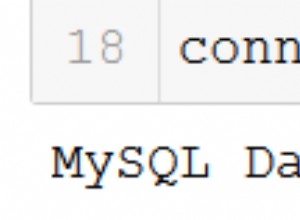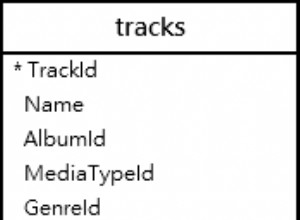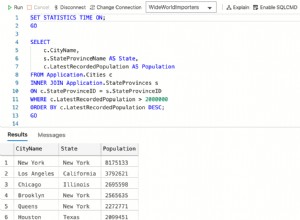ClusterControl può essere utilizzato per distribuire configurazioni di replica a disponibilità elevata. Supporta il passaggio e il failover per le configurazioni di replica MySQL o MariaDB basate su GTID. ClusterControl può distribuire diversi tipi di proxy per l'instradamento del traffico:ProxySQL, HAProxy e MaxScale. Questi sono integrati per gestire le modifiche alla topologia relative a failover o switchover. In questo post del blog, daremo un'occhiata a come funziona e cosa puoi aspettarti da ciascuno dei proxy.
Per prima cosa, esaminiamo alcune definizioni e terminologia. ClusterControl può essere configurato per eseguire un ripristino di un master di replica non riuscito:può promuovere uno slave a diventare il nuovo master, apportare le modifiche alla topologia richieste e ripristinare la capacità dell'intera configurazione di accettare scritture. Questo è ciò che chiameremo "failover". ClusterControl può anche eseguire un master switch, a volte è necessario cambiare un master. Lo scenario tipico sarebbe una modifica pesante dello schema, che deve essere eseguita in modo progressivo. Verso la fine della procedura, dovrai promuovere uno degli slave, a cui è già stata applicata la modifica, prima di eseguire la modifica sul vecchio master.
La principale differenza tra "failover" e "switchover" è che il failover, per definizione, è una situazione di emergenza in cui il master non è già disponibile. D'altra parte, il passaggio è un processo più controllabile su cui ClusterControl ha il pieno controllo. Se stiamo parlando di failover, non c'è modo di gestirlo con grazia poiché l'applicazione ha già perso le connessioni a causa di un arresto anomalo del master. Pertanto, indipendentemente dal proxy che utilizzerai, l'applicazione dovrà sempre riconnettersi.
Pertanto, le applicazioni devono essere in grado di gestire gli errori di transazione e riprovarli. L'altra cosa importante quando si parla di failover è la capacità del proxy di controllare lo stato dei server di database. Senza controlli di integrità, il proxy non può conoscere lo stato del server e quindi non può decidere di eseguire il failover del traffico. ClusterControl configura automaticamente questi controlli di integrità durante la distribuzione del proxy.
Failover
ProxySQL
Diamo un'occhiata a come potrebbe apparire il failover dal punto di vista dell'applicazione. Ci collegheremo prima al database usando ProxySQL versione 1.4.6.
[email protected]:~# while true ;do time sysbench /root/sysbench/src/lua/oltp_read_write.lua --threads=4 --max-requests=0 --time=3600 --mysql-host=10.0.0.105 --mysql-user=sbtest --mysql-password=pass --mysql-port=6033 --tables=32 --report-interval=1 --skip-trx=on --table-size=10000 --db-ps-mode=disable run ; done
sysbench 1.1.0-651e7fd (using bundled LuaJIT 2.1.0-beta3)
Running the test with following options:
Number of threads: 4
Report intermediate results every 1 second(s)
Initializing random number generator from current time
Initializing worker threads...
Threads started!
[ 1s ] thds: 4 tps: 29.51 qps: 585.28 (r/w/o: 465.27/120.01/0.00) lat (ms,95%): 196.89 err/s: 0.00 reconn/s: 0.00
[ 2s ] thds: 4 tps: 44.61 qps: 784.77 (r/w/o: 603.28/181.49/0.00) lat (ms,95%): 116.80 err/s: 0.00 reconn/s: 0.00
[ 3s ] thds: 4 tps: 46.98 qps: 829.66 (r/w/o: 646.74/182.93/0.00) lat (ms,95%): 121.08 err/s: 0.00 reconn/s: 0.00
[ 4s ] thds: 4 tps: 49.04 qps: 886.64 (r/w/o: 690.50/195.14/1.00) lat (ms,95%): 112.67 err/s: 0.00 reconn/s: 0.00
[ 5s ] thds: 4 tps: 47.98 qps: 887.64 (r/w/o: 689.72/197.92/0.00) lat (ms,95%): 106.75 err/s: 0.00 reconn/s: 0.00
FATAL: mysql_drv_query() returned error 2013 (Lost connection to MySQL server during query) for query 'UPDATE sbtest8 SET k=k+1 WHERE id=5019'
FATAL: `thread_run' function failed: /usr/local/share/sysbench/oltp_common.lua:461: SQL error, errno = 2013, state = 'HY000': Lost connection to MySQL server during query
FATAL: mysql_drv_query() returned error 2013 (Lost connection to MySQL server during query) for query 'DELETE FROM sbtest6 WHERE id=4957'
FATAL: `thread_run' function failed: /usr/local/share/sysbench/oltp_common.lua:490: SQL error, errno = 2013, state = 'HY000': Lost connection to MySQL server during query
FATAL: mysql_drv_query() returned error 2013 (Lost connection to MySQL server during query) for query 'SELECT SUM(k) FROM sbtest23 WHERE id BETWEEN 4986 AND 5085'
FATAL: `thread_run' function failed: /usr/local/share/sysbench/oltp_common.lua:435: SQL error, errno = 2013, state = 'HY000': Lost connection to MySQL server during query
FATAL: mysql_drv_query() returned error 2013 (Lost connection to MySQL server during query) for query 'DELETE FROM sbtest21 WHERE id=5218'
FATAL: `thread_run' function failed: /usr/local/share/sysbench/oltp_common.lua:490: SQL error, errno = 2013, state = 'HY000': Lost connection to MySQL server during query
real 0m5.903s
user 0m0.092s
sys 0m1.252s
sysbench 1.1.0-651e7fd (using bundled LuaJIT 2.1.0-beta3)
Running the test with following options:
Number of threads: 4
Report intermediate results every 1 second(s)
Initializing random number generator from current time
Initializing worker threads...
FATAL: unable to connect to MySQL server on host '10.0.0.105', port 6033, aborting...
FATAL: error 2003: Can't connect to MySQL server on '10.0.0.105' (111)
FATAL: `thread_init' function failed: /usr/local/share/sysbench/oltp_common.lua:352: connection creation failed
FATAL: unable to connect to MySQL server on host '10.0.0.105', port 6033, aborting...
FATAL: error 2003: Can't connect to MySQL server on '10.0.0.105' (111)
FATAL: `thread_init' function failed: /usr/local/share/sysbench/oltp_common.lua:352: connection creation failed
FATAL: unable to connect to MySQL server on host '10.0.0.105', port 6033, aborting...
FATAL: error 2003: Can't connect to MySQL server on '10.0.0.105' (111)
FATAL: `thread_init' function failed: /usr/local/share/sysbench/oltp_common.lua:352: connection creation failed
FATAL: unable to connect to MySQL server on host '10.0.0.105', port 6033, aborting...
FATAL: error 2003: Can't connect to MySQL server on '10.0.0.105' (111)
FATAL: `thread_init' function failed: /usr/local/share/sysbench/oltp_common.lua:352: connection creation failed
FATAL: Threads initialization failed!
real 0m0.021s
user 0m0.012s
sys 0m0.000s
sysbench 1.1.0-651e7fd (using bundled LuaJIT 2.1.0-beta3)
Running the test with following options:
Number of threads: 4
Report intermediate results every 1 second(s)
Initializing random number generator from current time
Initializing worker threads...
Threads started!
[ 1s ] thds: 4 tps: 0.00 qps: 55.81 (r/w/o: 55.81/0.00/0.00) lat (ms,95%): 0.00 err/s: 0.00 reconn/s: 0.00
[ 2s ] thds: 4 tps: 0.00 qps: 0.00 (r/w/o: 0.00/0.00/0.00) lat (ms,95%): 0.00 err/s: 0.00 reconn/s: 0.00
[ 3s ] thds: 4 tps: 0.00 qps: 0.00 (r/w/o: 0.00/0.00/0.00) lat (ms,95%): 0.00 err/s: 0.00 reconn/s: 0.00
[ 4s ] thds: 4 tps: 0.00 qps: 0.00 (r/w/o: 0.00/0.00/0.00) lat (ms,95%): 0.00 err/s: 0.00 reconn/s: 0.00
[ 5s ] thds: 4 tps: 0.00 qps: 0.00 (r/w/o: 0.00/0.00/0.00) lat (ms,95%): 0.00 err/s: 0.00 reconn/s: 0.00
[ 6s ] thds: 4 tps: 0.00 qps: 0.00 (r/w/o: 0.00/0.00/0.00) lat (ms,95%): 0.00 err/s: 0.00 reconn/s: 0.00
[ 7s ] thds: 4 tps: 0.00 qps: 0.00 (r/w/o: 0.00/0.00/0.00) lat (ms,95%): 0.00 err/s: 0.00 reconn/s: 0.00
[ 8s ] thds: 4 tps: 0.00 qps: 0.00 (r/w/o: 0.00/0.00/0.00) lat (ms,95%): 0.00 err/s: 0.00 reconn/s: 0.00
[ 9s ] thds: 4 tps: 0.00 qps: 0.00 (r/w/o: 0.00/0.00/0.00) lat (ms,95%): 0.00 err/s: 0.00 reconn/s: 0.00
[ 10s ] thds: 4 tps: 0.00 qps: 3.00 (r/w/o: 0.00/3.00/0.00) lat (ms,95%): 0.00 err/s: 0.00 reconn/s: 0.00
[ 11s ] thds: 4 tps: 58.99 qps: 1026.91 (r/w/o: 792.93/233.98/0.00) lat (ms,95%): 9977.52 err/s: 0.00 reconn/s: 0.00Come possiamo vedere da quanto sopra, il nuovo master è diventato disponibile entro circa 11 secondi dal crash. Durante questo periodo, ClusterControl ha promosso uno degli slave a diventare un nuovo master ed è diventato disponibile per le scritture.
HAProxy
Di seguito è riportato un estratto dall'output della nostra applicazione sysbench, quando si è verificato il failover durante la connessione tramite HAProxy. HAProxy è stato distribuito con la versione 1.5.14.
[email protected]:~# while true ;do date ; time sysbench /root/sysbench/src/lua/oltp_read_write.lua --threads=4 --max-requests=0 --time=3600 --mysql-host=10.0.0.105 --mysql-user=sbtest --mysql-password=pass --mysql-port=3307 --tables=32 --report-interval=1 --skip-trx=on --table-size=10000 --db-ps-mode=disable run ; done
Mon Mar 26 13:24:36 UTC 2018
sysbench 1.1.0-651e7fd (using bundled LuaJIT 2.1.0-beta3)
Running the test with following options:
Number of threads: 4
Report intermediate results every 1 second(s)
Initializing random number generator from current time
Initializing worker threads...
Threads started!
[ 1s ] thds: 4 tps: 38.62 qps: 748.66 (r/w/o: 591.21/157.46/0.00) lat (ms,95%): 204.11 err/s: 0.00 reconn/s: 0.00
[ 2s ] thds: 4 tps: 45.25 qps: 797.34 (r/w/o: 619.37/177.97/0.00) lat (ms,95%): 142.39 err/s: 0.00 reconn/s: 0.00
[ 3s ] thds: 4 tps: 46.04 qps: 833.66 (r/w/o: 647.51/186.15/0.00) lat (ms,95%): 155.80 err/s: 0.00 reconn/s: 0.00
[ 4s ] thds: 4 tps: 38.03 qps: 698.50 (r/w/o: 548.39/150.11/0.00) lat (ms,95%): 161.51 err/s: 0.00 reconn/s: 0.00
FATAL: mysql_drv_query() returned error 2013 (Lost connection to MySQL server during query) for query 'INSERT INTO sbtest26 (id, k, c, pad) VALUES (5019, 4641, '59053342586-08172779908-92479743240-43242105725-10632773383-95161136797-93281862044-04686210438-11173993922-29424780352', '31974441818-04649488782-29232641118-20479872868-43849012112')'
FATAL: `thread_run' function failed: /usr/local/share/sysbench/oltp_common.lua:491: SQL error, errno = 2013, state = 'HY000': Lost connection to MySQL server during query
FATAL: mysql_drv_query() returned error 2013 (Lost connection to MySQL server during query) for query 'INSERT INTO sbtest5 (id, k, c, pad) VALUES (4990, 5016, '24532768797-67997552950-32933774735-28931955363-94029987812-56997738696-36504817596-46223378508-29593036153-06914757723', '96663311222-58437606902-85941187037-63300736065-65139798452')'
FATAL: `thread_run' function failed: /usr/local/share/sysbench/oltp_common.lua:491: SQL error, errno = 2013, state = 'HY000': Lost connection to MySQL server during query
FATAL: mysql_drv_query() returned error 2013 (Lost connection to MySQL server during query) for query 'DELETE FROM sbtest25 WHERE id=4996'
FATAL: `thread_run' function failed: /usr/local/share/sysbench/oltp_common.lua:490: SQL error, errno = 2013, state = 'HY000': Lost connection to MySQL server during query
FATAL: mysql_drv_query() returned error 2013 (Lost connection to MySQL server during query) for query 'UPDATE sbtest16 SET k=k+1 WHERE id=5269'
FATAL: `thread_run' function failed: /usr/local/share/sysbench/oltp_common.lua:461: SQL error, errno = 2013, state = 'HY000': Lost connection to MySQL server during query
real 0m4.270s
user 0m0.068s
sys 0m0.928s
...
Mon Mar 26 13:24:47 UTC 2018
sysbench 1.1.0-651e7fd (using bundled LuaJIT 2.1.0-beta3)
Running the test with following options:
Number of threads: 4
Report intermediate results every 1 second(s)
Initializing random number generator from current time
Initializing worker threads...
FATAL: unable to connect to MySQL server on host '10.0.0.105', port 3307, aborting...
FATAL: error 2013: Lost connection to MySQL server at 'reading initial communication packet', system error: 0
FATAL: `thread_init' function failed: /usr/local/share/sysbench/oltp_common.lua:352: connection creation failed
FATAL: unable to connect to MySQL server on host '10.0.0.105', port 3307, aborting...
FATAL: error 2013: Lost connection to MySQL server at 'reading initial communication packet', system error: 2
FATAL: `thread_init' function failed: /usr/local/share/sysbench/oltp_common.lua:352: connection creation failed
FATAL: unable to connect to MySQL server on host '10.0.0.105', port 3307, aborting...
FATAL: error 2013: Lost connection to MySQL server at 'reading initial communication packet', system error: 2
FATAL: `thread_init' function failed: /usr/local/share/sysbench/oltp_common.lua:352: connection creation failed
FATAL: unable to connect to MySQL server on host '10.0.0.105', port 3307, aborting...
FATAL: error 2013: Lost connection to MySQL server at 'reading initial communication packet', system error: 2
FATAL: `thread_init' function failed: /usr/local/share/sysbench/oltp_common.lua:352: connection creation failed
FATAL: Threads initialization failed!
real 0m0.036s
user 0m0.004s
sys 0m0.008s
...
Mon Mar 26 13:25:03 UTC 2018
sysbench 1.1.0-651e7fd (using bundled LuaJIT 2.1.0-beta3)
Running the test with following options:
Number of threads: 4
Report intermediate results every 1 second(s)
Initializing random number generator from current time
Initializing worker threads...
Threads started!
[ 1s ] thds: 4 tps: 50.58 qps: 917.42 (r/w/o: 715.10/202.33/0.00) lat (ms,95%): 153.02 err/s: 0.00 reconn/s: 0.00
[ 2s ] thds: 4 tps: 50.17 qps: 956.33 (r/w/o: 749.61/205.72/1.00) lat (ms,95%): 121.08 err/s: 0.00 reconn/s: 0.00In totale, il processo ha richiesto 12 secondi.
Scala massima
Diamo un'occhiata a come MaxScale gestisce il failover. Usiamo MaxScale con la versione 2.1.9.
[email protected]:~# while true ; do date ; time sysbench /root/sysbench/src/lua/oltp_read_write.lua --threads=4 --max-requests=0 --time=3600 --mysql-host=10.0.0.106 --mysql-user=myuser --mysql-password=pass --mysql-port=4008 --tables=32 --report-interval=1 --skip-trx=on --table-size=100000 --db-ps-mode=disable run ; done
Mon Mar 26 15:16:34 UTC 2018
sysbench 1.1.0-651e7fd (using bundled LuaJIT 2.1.0-beta3)
Running the test with following options:
Number of threads: 4
Report intermediate results every 1 second(s)
Initializing random number generator from current time
Initializing worker threads...
Threads started!
[ 1s ] thds: 4 tps: 34.82 qps: 658.54 (r/w/o: 519.27/125.34/13.93) lat (ms,95%): 137.35 err/s: 0.00 reconn/s: 0.00
[ 2s ] thds: 4 tps: 35.01 qps: 655.23 (r/w/o: 513.18/142.05/0.00) lat (ms,95%): 207.82 err/s: 0.00 reconn/s: 0.00
[ 3s ] thds: 4 tps: 39.01 qps: 696.16 (r/w/o: 542.13/154.04/0.00) lat (ms,95%): 139.85 err/s: 0.00 reconn/s: 0.00
[ 4s ] thds: 4 tps: 40.91 qps: 724.41 (r/w/o: 557.77/166.63/0.00) lat (ms,95%): 125.52 err/s: 0.00 reconn/s: 0.00
FATAL: mysql_drv_query() returned error 1053 (Server shutdown in progress) for query 'UPDATE sbtest28 SET k=k+1 WHERE id=49992'
FATAL: `thread_run' function failed: /usr/local/share/sysbench/oltp_common.lua:461: SQL error, errno = 1053, state = '08S01': Server shutdown in progress
FATAL: mysql_drv_query() returned error 1053 (Server shutdown in progress) for query 'UPDATE sbtest14 SET k=k+1 WHERE id=59650'
FATAL: `thread_run' function failed: /usr/local/share/sysbench/oltp_common.lua:461: SQL error, errno = 1053, state = '08S01': Server shutdown in progress
FATAL: mysql_drv_query() returned error 1053 (Server shutdown in progress) for query 'UPDATE sbtest12 SET k=k+1 WHERE id=50288'
FATAL: `thread_run' function failed: /usr/local/share/sysbench/oltp_common.lua:461: SQL error, errno = 1053, state = '08S01': Server shutdown in progress
FATAL: mysql_drv_query() returned error 1053 (Server shutdown in progress) for query 'UPDATE sbtest25 SET k=k+1 WHERE id=50105'
FATAL: `thread_run' function failed: /usr/local/share/sysbench/oltp_common.lua:461: SQL error, errno = 1053, state = '08S01': Server shutdown in progress
real 0m5.043s
user 0m0.080s
sys 0m1.044s
Mon Mar 26 15:16:53 UTC 2018
sysbench 1.1.0-651e7fd (using bundled LuaJIT 2.1.0-beta3)
Running the test with following options:
Number of threads: 4
Report intermediate results every 1 second(s)
Initializing random number generator from current time
Initializing worker threads...
Threads started!
[ 1s ] thds: 4 tps: 46.82 qps: 905.61 (r/w/o: 710.34/195.27/0.00) lat (ms,95%): 101.13 err/s: 0.00 reconn/s: 0.00Riepilogo failover
È importante chiarire che questo non è un benchmark scientifico:la maggior parte delle volte viene utilizzato da ClusterControl per eseguire il failover. I proxy in genere richiedono al massimo un paio di secondi per rilevare la modifica della topologia. Abbiamo usato sysbench come nostra applicazione. È stato configurato per eseguire transazioni con impegno automatico, quindi non sono state utilizzate né transazioni esplicite né istruzioni preparate. Il carico di lavoro di lettura/scrittura di Sysbench è piuttosto veloce. Se disponi di transazioni o query di lunga durata, le prestazioni di failover saranno diverse. Puoi vedere il nostro scenario come un caso migliore.
Commutazione
Come accennato in precedenza, durante l'esecuzione di un passaggio ClusterControl ha un maggiore controllo del master. In alcune circostanze (come nessuna transazione, nessuna scrittura in esecuzione a lungo, ecc.), potrebbe essere in grado di eseguire un interruttore principale grazioso, purché il proxy lo supporti. Sfortunatamente, al momento, nessuno dei proxy distribuibili da ClusterControl è in grado di gestire un passaggio regolare. In passato, ProxySQL aveva questa capacità, quindi abbiamo deciso di indagare più da vicino e siamo entrati in contatto con il creatore di ProxySQL, René Cannaò. Durante l'indagine abbiamo identificato una regressione che dovrebbe essere corretta nella prossima versione di ProxySQL. Nel frattempo, per mostrare come dovrebbe comportarsi ProxySQL, abbiamo usato ProxySQL corretto con una piccola soluzione che abbiamo compilato dal sorgente.
[ 16s ] thds: 4 tps: 39.01 qps: 711.11 (r/w/o: 555.09/156.02/0.00) lat (ms,95%): 173.58 err/s: 0.00 reconn/s: 0.00
[ 17s ] thds: 4 tps: 49.00 qps: 879.06 (r/w/o: 678.05/201.01/0.00) lat (ms,95%): 102.97 err/s: 0.00 reconn/s: 0.00
[ 18s ] thds: 4 tps: 42.86 qps: 768.57 (r/w/o: 603.09/165.48/0.00) lat (ms,95%): 176.73 err/s: 0.00 reconn/s: 0.00
[ 19s ] thds: 4 tps: 28.07 qps: 521.26 (r/w/o: 406.98/114.28/0.00) lat (ms,95%): 235.74 err/s: 0.00 reconn/s: 0.00
[ 20s ] thds: 4 tps: 0.00 qps: 0.00 (r/w/o: 0.00/0.00/0.00) lat (ms,95%): 0.00 err/s: 0.00 reconn/s: 0.00
[ 21s ] thds: 4 tps: 0.00 qps: 0.00 (r/w/o: 0.00/0.00/0.00) lat (ms,95%): 0.00 err/s: 0.00 reconn/s: 0.00
[ 22s ] thds: 4 tps: 0.00 qps: 0.00 (r/w/o: 0.00/0.00/0.00) lat (ms,95%): 0.00 err/s: 0.00 reconn/s: 0.00
[ 23s ] thds: 4 tps: 13.98 qps: 249.59 (r/w/o: 193.68/55.91/0.00) lat (ms,95%): 4055.23 err/s: 0.00 reconn/s: 0.00
[ 24s ] thds: 4 tps: 81.06 qps: 1449.01 (r/w/o: 1123.79/325.23/0.00) lat (ms,95%): 62.19 err/s: 0.00 reconn/s: 0.00
[ 25s ] thds: 4 tps: 52.02 qps: 923.42 (r/w/o: 715.32/208.09/0.00) lat (ms,95%): 390.30 err/s: 0.00 reconn/s: 0.00
[ 26s ] thds: 4 tps: 59.00 qps: 1082.94 (r/w/o: 844.96/237.99/0.00) lat (ms,95%): 164.45 err/s: 0.00 reconn/s: 0.00
[ 27s ] thds: 4 tps: 50.99 qps: 900.75 (r/w/o: 700.81/199.95/0.00) lat (ms,95%): 130.13 err/s: 0.00 reconn/s: 0.00Come puoi vedere, nessuna query viene eseguita per 4 secondi ma nessun errore viene restituito all'applicazione e dopo questa pausa il traffico ricomincia a fluire.
Per riassumere, abbiamo dimostrato che ClusterControl, se utilizzato con ProxySQL o MaxScale o HAProxy, può eseguire un failover con un tempo di inattività di 10 - 15 secondi. Rispetto a un interruttore generale pianificato, nessuno dei proxy può gestire la procedura senza errori al momento della scrittura. Tuttavia, si prevede che la prossima versione di ProxySQL consentirà un passaggio di pochi secondi senza che venga visualizzato alcun errore nell'applicazione.




